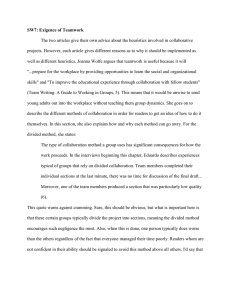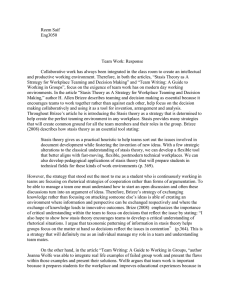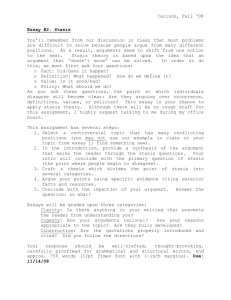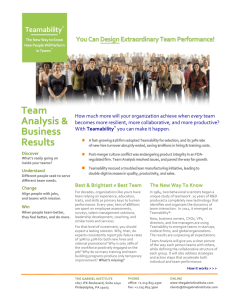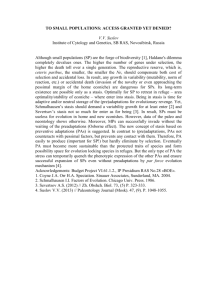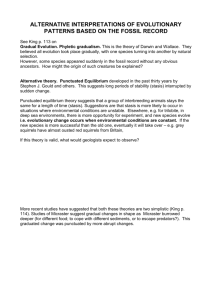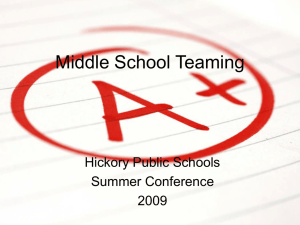Stasis Theory as a Strategy for Workplace Teaming and Decision
advertisement
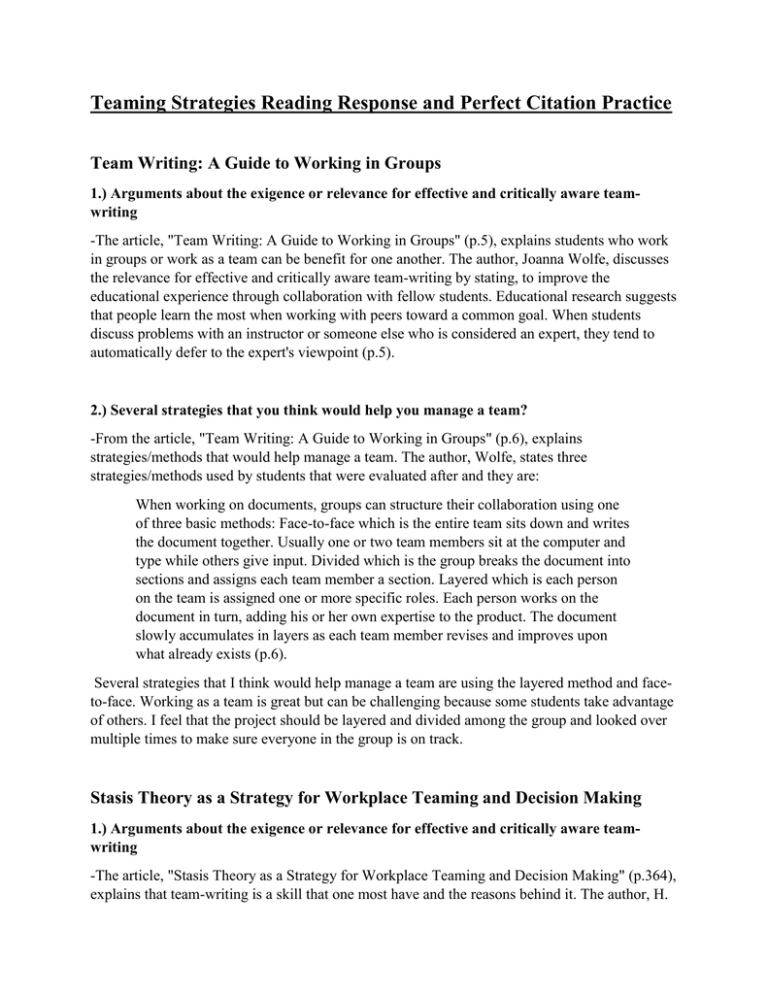
Teaming Strategies Reading Response and Perfect Citation Practice Team Writing: A Guide to Working in Groups 1.) Arguments about the exigence or relevance for effective and critically aware teamwriting -The article, "Team Writing: A Guide to Working in Groups" (p.5), explains students who work in groups or work as a team can be benefit for one another. The author, Joanna Wolfe, discusses the relevance for effective and critically aware team-writing by stating, to improve the educational experience through collaboration with fellow students. Educational research suggests that people learn the most when working with peers toward a common goal. When students discuss problems with an instructor or someone else who is considered an expert, they tend to automatically defer to the expert's viewpoint (p.5). 2.) Several strategies that you think would help you manage a team? -From the article, "Team Writing: A Guide to Working in Groups" (p.6), explains strategies/methods that would help manage a team. The author, Wolfe, states three strategies/methods used by students that were evaluated after and they are: When working on documents, groups can structure their collaboration using one of three basic methods: Face-to-face which is the entire team sits down and writes the document together. Usually one or two team members sit at the computer and type while others give input. Divided which is the group breaks the document into sections and assigns each team member a section. Layered which is each person on the team is assigned one or more specific roles. Each person works on the document in turn, adding his or her own expertise to the product. The document slowly accumulates in layers as each team member revises and improves upon what already exists (p.6). Several strategies that I think would help manage a team are using the layered method and faceto-face. Working as a team is great but can be challenging because some students take advantage of others. I feel that the project should be layered and divided among the group and looked over multiple times to make sure everyone in the group is on track. Stasis Theory as a Strategy for Workplace Teaming and Decision Making 1.) Arguments about the exigence or relevance for effective and critically aware teamwriting -The article, "Stasis Theory as a Strategy for Workplace Teaming and Decision Making" (p.364), explains that team-writing is a skill that one most have and the reasons behind it. The author, H. Allen Brizee, states current scholarship suggests that the ability to cooperate with subject-matter experts and coworkers is the primary skill professional writers must possess as they move into the workplace. However, an increasingly complex (technological and cultural) and dispersed workplace challenges writers' ability to cooperate (p. 364). 2.) Several strategies that you think would help you manage a team? -From the article, "Stasis Theory as a Strategy for Workplace Teaming and Decision Making" (p. 363), discusses strategies that would help manage a team and not come to a failure point. The author, Brizee, explains these strategies by: Professional writers must be able to use complex software for projects that are often completed by multidisciplinary teams working remotely. Moreover, as technical writers shift from content developers to project managers, our responsibilities now include user-advocacy and supervision, further invigorating the need for successful communication. This article offers a different vision of an ancient heuristic stasis theory as a solution for the teaming challenges facing today's professional writers. Stasis theory, used as a generative heuristic rather than an eristic weapon, can help foster teaming and effective decision making in contemporary pedagogical and workplace contexts (p.363). Several strategies that I think would help manage a team are using stasis during invention, audience analysis, and empirical. References Brizee, H. Allen. (2008). Stasis Theory as a Strategy for Workplace Teaming and Decision Making. J. Technical Writing and Communication, Vol. 38(4). Wolfe, Joanna. Team Writing: A Guide to Working in Groups. Boston/ New York.
